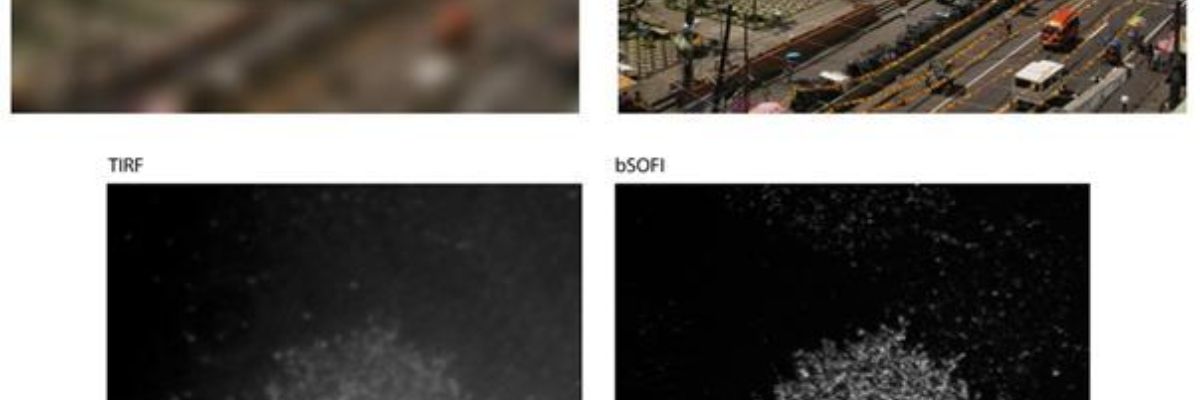
New possibilities of super-resolution microscopy
New possibilities of super-resolution microscopy
Wed Jan 03 15:42:27 CET 2018
A team of scientists from the J. Heyrovsky Institute of Physical Chemistry of the CAS in collaboration with the EPFL in Switzerland has improved the possibilities of fluorescent super-resolution microscopy, for which the Nobel Prize was awarded in 2014. According to the leader of the research Marek Cebecauer, the new method can significantly shift for instance the understanding of the function of the human immunity system or the origin of neurodegenerative diseases. Information on the new method was published in the journal Nature Communications.
The newly developed method using the characteristics of fluorescent super-resolution microscopy (bSOFI) allows the monitoring of the processes in the cells or on their surface at a resolution of approximately 25 nanometres (milliardth of a metre). That image is ten-times sharper than in the case of standard microscopy (see figure). The method focuses on the density of the individual molecules in specific localities and in certain aspects moves the existing boundaries of super-resolution microscopy.
“In a nutshell, it is as if we could finally recognize individual trees on a satellite photograph of the forest. The method itself is quite complicated, but we make it freely available in the published work and begin to work on a user-friendly software so it can be used more extensively, because the possibilities of its usage are broad,” says the team leader Marek Cebecauer from the J. Heyrovsky Institute of Physical Chemistry.
As a biochemist, Marek Cebecauer decided to use the new method in research of the immunity system. “We are interested in lymphocyte function and generally human immunity,” he explains. “Molecules on the surface of lymphocytes, such as white blood cells, are not randomly distributed. We discover them in clusters. But why? Nobody knows exactly, and there are a few theories on why this happens. By monitoring at a higher resolution, we can learn a lot of new information about the organization of molecules that affect various important processes, including the function or non-functioning of our body’s defence system,” he believes.
In most cases, human disease is explained by a loss of the function of an important substance in our body, mainly for the reasons of its absence of insufficient presence. Other times, there is on the contrary too much of this substance. “However, in many cases, this explanation fails. Therefore, other theories and hypotheses are offered, for instance the disruption of a precise grouping of the specific substance. But not much is known even now about the accurate localization of substances in our body,” explains Marek Cebecauer.
According to him, the reason is the lack of availability of suitable methods for the study of molecules in cells with the precision of a few nanometres. Marek Cebecauer’s group focuses exactly on the study of the precise localization of the important molecules in our body, specifically in the immunity and neural cells. “We are trying to describe the effect of changes in the location of specific substances on the function of the immune system and thus to decipher the causes of diseases about which we do not yet know much. We need the best imaging techniques for our research,” he adds on the newly developed imaging method.
Can we understand Alzheimer’s Disease?
The examination of the interactions of immunity cells with their surroundings on the most elementary level can explicate how all of this complicated system in our bodies communicated and decides together. “It can theoretically help to understand the patterns of the onset and course of autoimmune diseases or, on the contrary, insufficient immune responses, including cancer. We are particularly interested in the influence of the factors of modern society, such as heavy stress, on the development of mental problems,” says Cebecauer.
According to the leader of the research, we speak last but not least about neurodegenerative diseases, such as Alzheimer’s or Parkinson’s Diseases. “An explanation of their onset in the earlier stages of life is lacking for both. The current results lead predominantly to the consequences, which however does not help in the design of the treatment. Through our method, it should be possible to recognize the changes of the arrangement of the critical substances participating in the development of these diseases, classify them better and monitor how they react to the various changes caused by the ageing of the organism or the worsening environment,” describes Cebecauer.
The development of a new imaging method was an interdisciplinary affair. Biologists, biochemists and leading computer scientists, includingemployees of the EPFL in Lausanne, Switzerland and the Institute of Molecular Genetics of the CAS took part in the creation of the new method. Besides the application of the method on the study of cells and work on the development of the relevant software, the team of scientists is now seeking to development of a 3D variety of this method, but it all relies on grants. “We would need new tailor-made optics and more supersensitive cameras. We are talking about amounts in the single digits of millions of Czech korunas,” concludes Cebecauer. On the contrary, the computing power of contemporary computers is adequate. According to Cebecauer, contemporary gaming computers with their graphic cards are sufficient even for the study of the functions of the human body.
Prepared by: J. Heyrovsky Institute of Physical Chemistry of the CAS in cooperation with the Department of Media Communication of the Head Office of the CAS
Photo: J. Heyrovsky Institute of Physical Chemistry of the CAS
